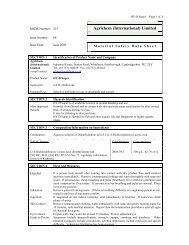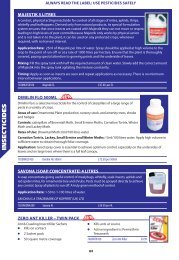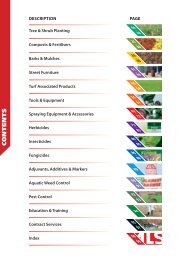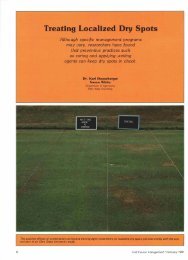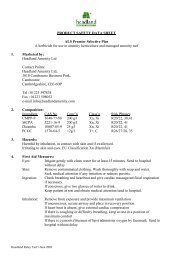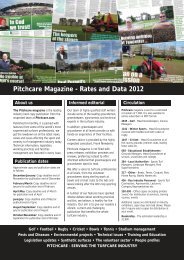Earning his Spurs - Pitchcare
Earning his Spurs - Pitchcare
Earning his Spurs - Pitchcare
You also want an ePaper? Increase the reach of your titles
YUMPU automatically turns print PDFs into web optimized ePapers that Google loves.
Waves ...<br />
and an almost full time mechanic, Geoff<br />
Duquemin, who works thirty hours a<br />
week and has been part of the team for<br />
six years.”<br />
“I call in extra labour as required<br />
during the growing season, just to keep<br />
up with rough cutting, which takes up to<br />
forty hours a week, and tees and fairway<br />
divoting, to which twenty-four hours are<br />
allocated. I also take in a student from a<br />
French horticultural/agricultural college<br />
for between four to eight weeks each<br />
year.”<br />
Drainage<br />
“With the course being below the high<br />
water mark, flooding is a problem and<br />
drainage essential. There are a network<br />
of ditches - douits, pronounced ‘dwee’ in<br />
the local patois - that criss-cross the<br />
fairways. These carry the water, that<br />
enters through the boundaries at around<br />
twenty different places, to one outlet that<br />
runs under the coast road through a<br />
three foot pipe to the beach.”<br />
“T<strong>his</strong> pipe has a non return valve<br />
halfway through that closes when the tide<br />
rises - there is over ten metres height<br />
difference from the highest and lowest<br />
tides - and the inward pressure of the sea<br />
is higher than the outward pressure of<br />
the water in the drainage ditch.”<br />
“The non return on a high tide can<br />
keep the gate closed for up to six hours<br />
and, with two tides a day, t<strong>his</strong> is always a<br />
problem during winter months. T<strong>his</strong> can<br />
become a problem when high tides and<br />
rain cause the ditches to fill and, on<br />
occasions flow over the fairways. We have<br />
been known to row a boat across six<br />
fairways without touching dry land.”<br />
“To help control the flooding, a pump<br />
is positioned near the beach that lifts<br />
water from the main ditch to the beach<br />
up a ten inch suction pipe to the pump<br />
ten feet above. The water is then pushed<br />
along a further sixty feet, and up another<br />
five feet, to the coast road drains where it<br />
then passes under the road to an outlet<br />
just above high tide mark to the beach.”<br />
“During the past winter the pump ran<br />
from late November to early January,<br />
non-stop, pumping 2,000,000 gallons a<br />
day, using around four litres of fuel per<br />
hour - thank God for red diesel. The<br />
pump can be manually controlled or put<br />
on a float switch. We keep it on float<br />
most of the time.”<br />
“On the outlet pipe, on the course<br />
GuernseySport<br />
side, there is a gate valve that can be<br />
lowered in times of drought to keep<br />
water in the ditches and raise the water<br />
table to keep the fairways green. But, t<strong>his</strong><br />
would have to be carefully monitored,<br />
and we have not needed to resort to t<strong>his</strong><br />
yet.”<br />
Design<br />
“Originally designed by Fred Hawtree, as<br />
a 9 hole, par 35, it was subsequently<br />
extended by <strong>his</strong> son, Martin, to an 18<br />
hole, par 64. It is a very challenging<br />
course with ponds, lakes and open<br />
ditches in play on all but one of the<br />
holes. Even from t<strong>his</strong> tee though, a<br />
shanked ball can find water! Martin<br />
Hawtree still visits us regularly, the last<br />
time was in February of t<strong>his</strong> year.”<br />
“All of the greens and tees were<br />
constructed from the native soil - a<br />
mixture of peat, sand and clay - dug out<br />
when creating the lakes and realigning<br />
and widening the ditches.”<br />
“Over 17,000 trees have been planted.<br />
There is quite a contrast in environment<br />
around the course, from exposed coastal<br />
areas to sheltered woodland further from<br />
the sea. We have had to put various<br />
species around the course, most of which<br />
71



